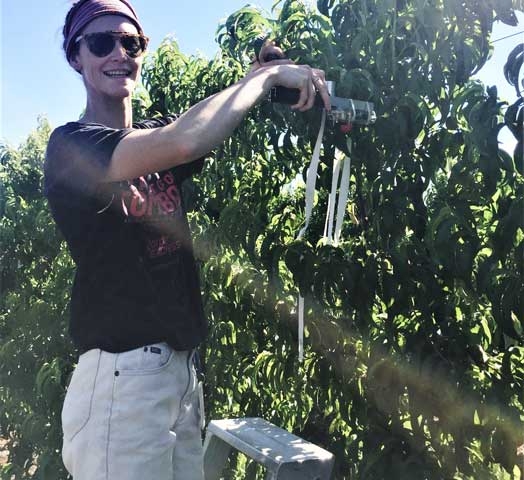Consumers prefer highly coloured fruit. Consequently, retailers require minimum percentages of blush on fruit as delivery standards.
Modern stone fruit cultivars are bred to have a high percentage of their surface naturally coloured.
However, there can be substantial variability in colouring within the canopy, mostly due to shading—which can be more pronounced under certain training systems (for example the bottom parts of vase, or behind upright shoots in vertical leader).
The lower colouring percentage fruit becomes noticeable on retailer shelves when mixed with fruit with a higher colouring percentage.
Need for some shading
Australian, and especially Victorian summer conditions, are characterized by high solar radiation and high temperatures. Some shading of fruit is therefore required to avoid sun damage such as blotching or even physical damage (skin and flesh breakdown).
Protection of fruit from the sun through foliage shading is a practice used by growers, however, shading can affect fruit quality (sweetness, acidity, colour and maturity), especially when associated with high crop loads.
Areas that are fully exposed to light, such as the top of the canopy, could have higher levels of locally produced photosynthates accumulating in the fruit whereas shaded areas at the bottom of the canopy will have less locally produced photosynthates.
Another common grower practice is to summer prune with the aim of opening up the canopy to expose fruit to the sun. This improves fruit quality by increasing photosynthetic levels of the nearby exposed leaves but at the same time it risks sun damage.
Better orchard design
An alternative to summer pruning is to design orchards (trellis system, row orientation, summer pruning) to maximise light interception in the canopy when photosynthesis is at a maximum (usually in the morning) and shade fruit when sun damage is most likely to occur (in the afternoon).
Agriculture Victoria established an experiment (the Sundial Orchard) at the Tatura SmartFarm to investigate the effects of row orientation and tree training on yield and fruit quality.
This article reports a concurrent physiological study on fruit colour development that will provide background response functions to complement the Sundial orchard.
Trial overview
The study was undertaken using Autumn Bright nectarine on fully grown 4-year-old trees trained as double vertical leader spaced at 4 x 1 m.
To better understand the interaction between light exposure and crop load on colour development, fruit were selected at the top of the canopy where natural light interception would be highest.
Fruit were either fully exposed or shaded by the canopy (Picture 1) depending on the time of the day.
Three crop loads (i.e. fruit number per tree) were investigated:
• low (roughly half the normal grower practice)
• medium (normal grower practice) and
• high (close to double the normal grower practice).
Thirty fruit per crop load, split into the two sides of the canopy (east and west) were selected for a total of 90 fruit.
The selected fruit were monitored during the season for light exposure, size (fruit diameter) and blush colour.
Blush colour development was monitored during the season by measuring Hue angle. Decreasing Hue angle value indicates increased blush redness.
Maturity index (IAD*) was measured approximately weekly from four weeks prior to harvest. At harvest, size, maturity, blush colour and sweetness of fruit were measured.
Observations
Fruit size was not affected by light exposure or tree side, only by the number of fruits, with the low crop load showing the bigger fruit, as expected.
(continued next month)
See this article in Tree Fruit May 2020






















